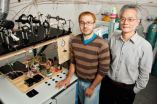(Press-News.org) CHAMPAIGN, Ill. — According to a popular hypothesis, grasses such as maize, sugar cane, millet and sorghum got their evolutionary start as a result of a steep drop in atmospheric carbon dioxide levels during the Oligocene epoch, more than 23 million years ago. A new study overturns that hypothesis, presenting the first geological evidence that the ancestors of these and other C4 grasses emerged millions of years earlier than previously established.
The findings are published in the journal Geology.
C4 plants are more efficient than C3 plants at taking up atmospheric carbon dioxide and converting it into the starches and sugars vital to plant growth. (C3 and C4 refer to the number of carbon atoms in the first molecular product of photosynthesis.) Having evolved relatively recently, C4 plants make up 3 percent of all living species of flowering plants. But they account for about 25 percent of global plant productivity on land. They dominate grasslands in tropical, subtropical and warm temperate areas. They also are a vital food source and an important feedstock for the production of biofuels.
"C4 plants are very successful, they're economically very important, but we actually don't know when they originated in the geological history," said University of Illinois plant biology professor Feng Sheng Hu, who led the new analysis. "To me, it's one of the most profound geological and ecological questions as a paleoecologist I can tackle."
A previous study dated the oldest C4 plant remnant found, a tiny fragment called a phytolith, to about 19 million years ago. Other studies analyzed the ratios of carbon isotopes in bulk soil samples to determine the ratio of C3 to C4 plant remains at different soil horizons, which correspond to different geological time periods. (C3 and C4 plants differ in their proportions of two carbon isotopes, C-12 and C-13.) Those studies indicated that C4 grasses were present as early as the Early Micocene, about 18 million years ago.
Rather than analyzing plant matter in bulk sediment samples, David Nelson, a postdoctoral researcher in Hu's lab at the time of the study (now a professor at the University of Maryland), analyzed the carbon isotope ratios of individual grains of grass pollen, a technique he pioneered while working with Hu in the lab of biogeochemistry professor Ann Pearson at Harvard University.
Using a spooling-wire micro-combustion device to combust the grains, and an isotope mass spectrometer to determine the relative ratio of C-12 and C-13 in the sample, Nelson and Illinois graduate student Michael Urban analyzed hundreds of individual grains of grass pollen collected from study sites in Spain and France.
"Because we analyze carbon isotopes in a material unique to grasses (pollen) we were able to detect C4 grasses at lower abundances than previous studies," Nelson said.
This analysis found "unequivocal evidence for C4 grasses in southwestern Europe by the Early Oligocene," the authors wrote. This means these grasses were present 32 to 34 million years ago, well before studies indicate atmospheric carbon dioxide levels made their precipitous decline.
"The evidence refutes the idea that low (atmospheric) CO2 was an important driver and/or precondition for the development of C4 photosynthesis," the authors wrote.
"This study challenges that hypothesis and basically says that something else was responsible for the evolution of C4 plants, probably higher temperature or drier conditions," Hu said. With atmospheric carbon dioxide levels now on the increase, he said, "there are also implications about how C3 and C4 plants will fare in the future."
INFORMATION:
Researchers from Harvard University; the Universidad de Granada, Spain; and the Bureau de Recherche Géologiques et Minières, France, also contributed to the study.
The University of Illinois Research Board, the National Science Foundation, and the David and Lucille Packard Foundation Fellowships Program supported this study.
Editor's notes: To reach Feng Sheng Hu, call 217-244-2982; e-mail fhu@illinois.edu.
The paper, "Isotopic Evidence of C4 Grasses in Southwestern Europe During the Early Oligocene-Middle Miocene," is available online and from the U. of I. News Bureau.
Study rewrites the evolutionary history of C4 grasses
2010-11-17
ELSE PRESS RELEASES FROM THIS DATE:
Program for young students increases interest in college attendance and medical careers
2010-11-17
Two new studies have shown that a unique program in East Harlem that helps middle school students learn practical health skills and gain a better understanding of medical conditions, such as diabetes and hypertension, resulted in increased interest in college attendance and medical careers among the students who attended the program. The results were presented at the American Public Health Association (APHA) Annual Meeting this month in Denver.
The MedStart Summer Enrichment Program was created in the summer of 2009 by Edward Chu and Melissa Schneiderman, two third-year ...
Researchers link cerebral malaria to epilepsy, behavior disorders
2010-11-17
EAST LANSING, Mich. — Almost a third of cerebral malaria survivors developed epilepsy or other behavioral disorders in the most comprehensive study to date of the disease in African children, solidifying the link between malaria and neuropsychiatric disorders that affect hundreds of thousands of children.
The research – led by Gretchen Birbeck, an associate professor of neurology and ophthalmology in Michigan State University's College of Osteopathic Medicine – appears in the current edition of The Lancet Neurology.
Cerebral malaria is a severe form of malaria affecting ...
Nanotechnology: A dead end for plant cells?
2010-11-17
Using particles that are 1/100,000 the width of a human hair to deliver drugs to cells or assist plants in fighting off pests may sound like something out of a science fiction movie, but these scenarios may be a common occurrence in the near future.
Carbon nanotubes, cylindrically shaped carbon molecules with a diameter of about 1 nanometer, have many potential applications in a variety of fields, such as biomedical engineering and medical chemistry. Proteins, nucleic acids, and drugs can be attached to these nanotubes and delivered to cells and organs. Carbon nanotubes ...
NERSC supercomputing center breaks the petaflops barrier
2010-11-17
BERKELEY, Calif.—The Department of Energy's National Energy Research Scientific Computing Center (NERSC), already one of the world's leading centers for scientific productivity, is now home to the fifth most powerful supercomputer in the world and the second most powerful in the United States, according to the latest edition of the TOP500 list, the definitive ranking of the world's top computers.
NERSC's newest supercomputer, a 153,408 processor-core Cray XE6 system, posted a performance of 1.05 petaflops (quadrillions of calculations per second) running the Linpack benchmark. ...
Infant estrogen levels tracked through diaper research
2010-11-17
With the help of babies and more than 5,000 of their diapers, Emory University researchers have developed an accurate, noninvasive method to determine estrogen levels in infants.
The method, previously used in nonhuman primates, will allow researchers to learn more about the association between estrogen levels in human infants and their long-term reproductive development as well as the development of sex-specific behaviors, such as toy preference or cognitive differences. What's more, the method will also allow researchers to look at how early disruption of the endocrine ...
Budding research links climate change and earlier flowering plants
2010-11-17
VIDEO:
University of Cincinnati researcher Denis Conover has cataloged countless plant species in the Cincinnati, Ohio, area in recent years.
Click here for more information.
According to research published today by a University of Cincinnati faculty member, native plants in southwestern Ohio are flowering significantly earlier, a finding he attributes, at least in part, to global warming.
UC biologist Denis Conover, field service associate professor, has spent countless ...
Enzyme action could be target for diabetes, heart disease treatments
2010-11-17
CINCINNATI—Cardiac researchers at the University of Cincinnati (UC) have found a new cellular pathway that could help in developing therapeutic treatments for obesity-related disorders, like diabetes and heart disease.
This research is being presented at the American Heart Association's Scientific Session in Chicago Nov. 16.
Tapan Chatterjee, PhD, and researchers in the division of cardiovascular diseases found that action by the enzyme histone deacetylase 9 (HDAC9) can lead to obesity-induced body fat dysfunction and that HDAC9-regulated pathways could be targets for ...
Detroit's urban farms could provide a majority of produce for local residents
2010-11-17
EAST LANSING, Mich. — Transforming vacant urban lots into farms and community gardens could provide Detroit residents with a majority of their fruits and vegetables.
As city officials ponder proposals for urban farms, a Michigan State University study indicates that a combination of urban farms, community gardens, storage facilities and hoop houses – greenhouses used to extend the growing season – could supply local residents with more than 75 percent of their vegetables and more than 40 percent of their fruits.
The study, which appears in the current issue of The Journal ...
MRI scans show structural brain changes in people at risk for Alzheimer's disease
2010-11-17
(CHICAGO) – New results from a study by neuroscientists at Rush University Medical Center suggest that people at risk of developing Alzheimer's disease exhibit a specific structural change in the brain that can be visualized by brain imaging. The findings may help identify those who would most benefit from early intervention.
The study will be presented at Neuroscience 2010, the annual meeting for the Society of Neuroscience in San Diego, Calif., on Wednesday, November 17.
"One of the main challenges in the field of Alzheimer's disease is identifying individuals at ...
Astronomers discover merging star systems that might explode
2010-11-17
VIDEO:
The binary star system J0923+3028 consists of two white dwarfs that are gradually spiraling in toward each other. In about 100 million years they will merge. Since their combined mass...
Click here for more information.
Sometimes when you're looking for one thing, you find something completely different and unexpected. In the scientific endeavor, such serendipity can lead to new discoveries. Today, researchers who found the first hypervelocity stars escaping the ...




